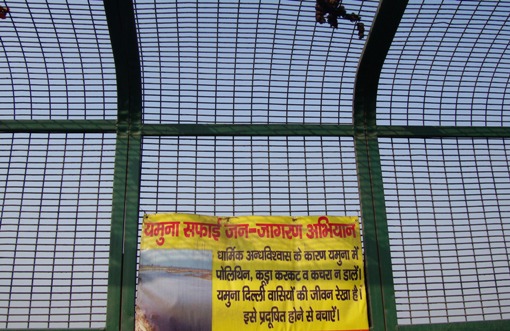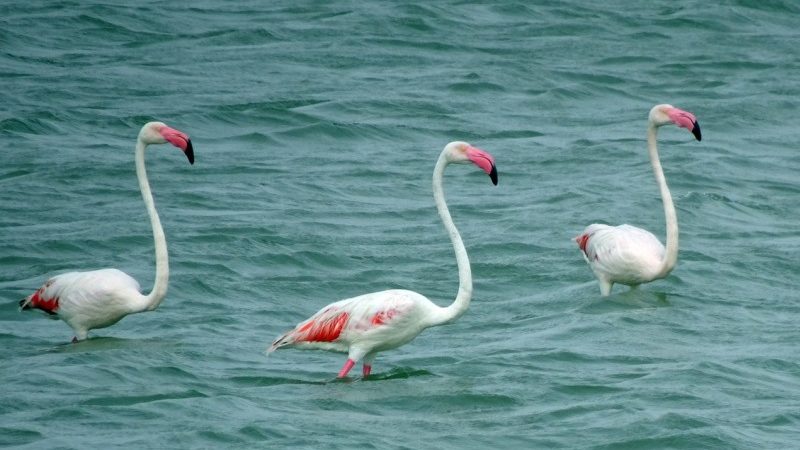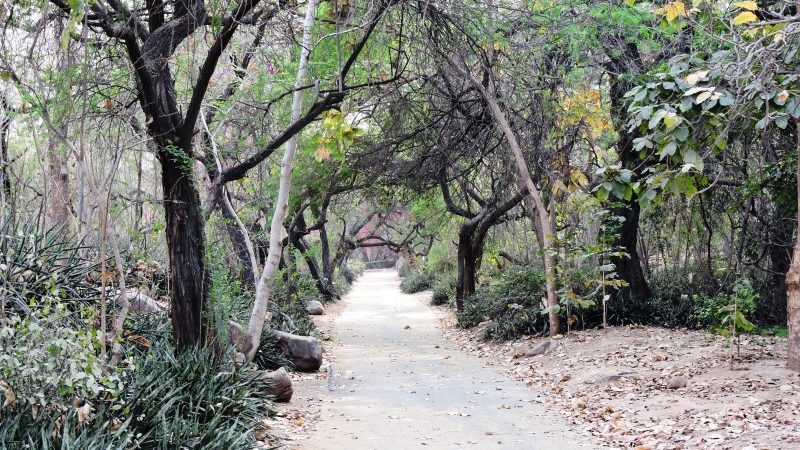Yamuna Yatra to Delhi: Wake Up Call for Delhiites

A public notice on the enclosure along a bridge on River Yamuna in Delhi.
River Yamuna is the principal fresh water source for the over 1.67 crore (16+ million) population of the National Capital Territory (NCT) of Delhi. Already, the city is parched and there is a gap of over 250 million gallons (per day) between water demand and supply. This 250 million gallons is perhaps entirely met by drilling of private borewells.
The indiscriminate dependency on Delhi’s ground water resource is evident from the rapidly declining ground water table which has fallen beyond recovery in some parts of the NCT. As if this wasn’t enough, surface and ground water quality in Delhi is increasingly getting contaminated with biological and potentially toxic pollutants.
A large part of Delhi’s ground water is recharged through interaction with the surface water bodies, of which River Yamuna is the most prominent. River Yamuna is thus the lifeline of Delhi and its pollution is impacting the city in numerous ways today.
However, even though the health and well being of the 16+ million people of Delhi is directly dependent on the health of River Yamuna, it took a ‘Delhi march’ by the not-so-urban people of Vrindavan (and the rest of the country) for pushing the agenda of cleaning River Yamuna in the Parliament of India. Gathered outside the border of Delhi, in numbers no less than scores of thousand, these river activists are on foot, in tractor-trolleys and even on bullock carts.
After having first denied permission to enter Delhi and later given selective entry, they are now scattered across conventional protest sites in the city. They are neither armed with social media tools, nor are they showing signs of aggression. In fact a large number of these activist are the not-so-urban womenfolk. Yet in less than 24 hours, the impact of their protest march can be seen in the highest corridors of political power.
The issue of River Yamuna’s polluted status is now echoing in the Parliament of India and letters have been exchanged among Chief Ministers and Union Ministers of Environment and Water Resources amidst threats of ‘Sansad march‘ (walk to Parliament) by these not-so-urban protesters.
The larger question that arises out of this situation is that even when a prominent demand of these river activists is to clean the 22 km ‘Delhi stretch’ of River Yamuna, where are the protesting voices from Delhi? One cannot help but look back to the Yamuna Satyagrah Campaign in 2007, when another set of river activists sat on the floodplain of the river in Delhi. They were protesting against the construction of the Commonwealth Games (CWG) Village on the River Yamuna floodplain. They too were supported by the people of Rajasthan and Uttar Pradesh (although not in as large numbers as in the present case) and had little, if any, support from Delhiites.
The campaign could not prevent the encroachment of River Yamuna’s floodplain and the CWG 2010 irreversibly damaged the prospects of sustainable urban growth of Delhi megacity. Even then, the citizens of Delhi did not speak up with the force and resilience that was required to push for long term survivability of all as compared to short term gains for few. The CWG Village flats are now occupied by those who could afford them and the city sold the very river and its floodplain which had been nourishing it since time immemorial.
This leads to the conclusion that either the citizens of Delhi are too pressurized with the daily hustle and bustle of urban life to take out time for such ‘abstract’ issues or have enough financial resources to buy their way out of the water crisis, no matter how unsustainable the means. Or perhaps both. How else can one understand the fact that despite the reported deficit in water availability (in million gallons), the citizens of Delhi (in millions) are non-responsive and indifferent to the ‘depleting’ water scenario.
Such is the indifference and inaction that last year, the Central Pollution Control Board found the polluted stretch of River Yamuna to have increased from 500 km to 600 km. Crores of public money has, for lack of a better phrase, gone down the drain even when the polluted stretch of the river (Delhi being the chief contributor) has increased by 100 km.
This too largely went unnoticed in the ‘hustle and bustle of urban life’ as did the fact that during the Sankranti festival (when devotees take holy dip in rivers to mark the beginning of the harvest season) in January this year, no devotees turned up to take the holy dip in River Yamuna in its ‘Delhi stretch’.
However, now that the impact of Delhi’s urban metabolism is being felt by downstream cities (of which Vrindavan is one), Delhiites will probably have to wake up to different kind of realities. Thousands more could walk towards Delhi in an attempt to convey their feelings about the river or urge for its cleaning so it doesn’t impact them downstream. The Delhi Police may not always be successful in regulating (as it did this time, albeit undemocratically) the flow of masses into the city with a focused demand of river cleanup.
The threat of getting stranded in traffic may only get more real and large number of Delhiites may be forced to ‘join in the protest’. River Yamuna is polluted largely due to the stopping of river flow north of Delhi (Wazirabad barrage) and joining of drains carrying partially treated/ untreated waste water downstream of the Wazirabad barrage.
The least the citizens of Delhi can urge the Government is to ensure the setting up of waste water treatment plants at the mouth of each of these drains, just before they meet the river. After having spent crores on river cleaning, it is indeed a wonder how this hasn’t happened thus far.
Whatever be our mode of protest, and no matter how busy we all may well be, the call for action for cleaning River Yamuna has been made. We can either join the protests now when we can, or wait a little longer until when we will be made to.




Youth Fraternity Foundation ®
No.12, (Second Floor), Calypso Bistro, Hauz Khas Village, New Delhi 110 016
To,
President
Delhi
Subject: How to rid Yamuna of pollution
Dear Sir,
In pursuit of our zeal to clean up our sacred rivers the Ganga and Yamuna and restore their original glory, we are writing to you again, in the hope that you would consider our humble submission sympathetically and allow (YFF) us to contribute to the cleaning up of these rivers and all the water bodies across India.
This is our considered view that the Ganga and Yamuna are important rivers because of their geographical and religious position in India. Therefore, it is our bounden duty and obligation to rid them of pollution. Since we inherited these majestic rivers in their original glory, it is but natural that we must restore their originality. History beckons us that we must not fail in our duty.
As things stand today, it is very unlikely that we will see a clean and serene Ganga and Yamuna in any foreseeable future, through it may sound a bit pessimistic.
EXISTING PROBLEM
It is a matter of great concern that these rivers continue to be ever polluted. In fact, more polluted than before (Supreme Court) in spite of the best and diligent efforts by the government as well as numerous organizations (religious, spiritual, social etc.) the result is far from satisfactory. Why is it that we have nothing to show for our efforts? How long can we go on removing the debris from Yamuna river’s bed ritualistically? We are afraid, this is an exercise in futility.
WHERE DO WE GO FROM HERE?
We humbly submit that we need to adopt Mahatma Gandhi’s way. As he showed the world and India, in particular, how the participation and overwhelming support of the mass, can bring a mighty empire to its knees. What I am trying to imply is,
government alone can not do this, public support is crucial. This can be easily done in close co-ordination with YOUTH FRATERNITY FOUNDATION. We have the mass support behind us for our innovative pilot project, and have had successful trial runs in many parts of Delhi. But we lack wherewithal, and the government have wherewithal but overwhelming public support.
It is said about Steve Jobs (late CEO, Apple Inc.) when he approached the present company, with his innovative ideas, he was pooh-poohed, only to take him back as CEO later.
Sir, we wish to bring into your kind notice that our country is a religious country, and people can not be stopped from worshipping and offering flowers to deities, stopping them, would be considered sacrilege.
There is an upcoming event Yamunaji’s birthday on 16th April 2013 and YFF is going to use this occasion to spread awareness through mass contact and interaction. We would appreciate if you kindly help us with some grants (monetary assistance) as we would be needing massive manpower and other materials.
Another thing that we wish to inform you is, the Ram Navami, next month, April and our reliable sources have informed us that on 18 and 19 April, 2013 almost 6.5 lakh kg. of worshipping materials and ceremonial flowers will be thrown into the Yamuna. If you co-operate with us, we can take care of this too.
Hoping that you will consider our humble request sympathetically and oblige us.
Thanking you,
Yours faithfully,
Gopi Dutt Aakash
( President )
Youth Fraternity Foundation (Regd.)